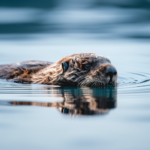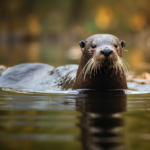Sea otters, those adorable marine mammals, are known for their playful behavior and their affinity for water. But have you ever wondered if these creatures live in groups? Well, the answer is yes! Sea otters are highly social animals and often form groups called rafts. These rafts can consist of anywhere from a few individuals to hundreds of otters. In this article, we will delve deeper into the fascinating world of sea otter social dynamics, exploring how they interact with one another, the benefits of living in groups, and the factors that influence their social behavior. So, let’s dive in and discover the captivating world of sea otter communities!
Key Takeaways
- Sea otters are social animals and typically live in groups called rafts.
- Rafts can consist of anywhere from a few individuals to hundreds of otters.
- Living in groups provides benefits such as increased protection, social interaction, and cooperative foraging.
- Sea otters communicate through vocalizations, body language, and tactile interactions within their groups.
- The size and composition of rafts can vary depending on factors such as habitat availability and resource abundance.
The Social Structure of Sea Otters
Sea otters are fascinating creatures that live in coastal waters and are known for their playful behavior and adorable appearance. But have you ever wondered how these marine mammals interact with each other? In this section, we will explore the social structure of sea otters and shed light on their group dynamics.
A. Understanding the Group Dynamics of Sea Otters
Sea otters are highly social animals and often live in groups called “rafts.” These rafts can consist of anywhere from a few individuals to hundreds of otters, depending on the availability of resources and the size of the population. Within these rafts, sea otters engage in various social behaviors, such as grooming, playing, and foraging together.
One interesting aspect of sea otter group dynamics is their preference for forming same-sex groups. Male otters tend to form bachelor groups, while females and their offspring form female-dominated groups. This separation of sexes within the raft helps to reduce competition and maintain a harmonious social structure.
B. Comparing Sea Otters and River Otters: Do Both Species Live in Groups?
While sea otters are known for their gregarious nature, river otters, which inhabit freshwater habitats, have a slightly different social structure. River otters are more solitary in nature and typically live in smaller family groups. These family groups consist of a breeding pair and their offspring, and they tend to stay together until the young otters reach adulthood.
Unlike sea otters, river otters do not form large rafts or engage in extensive social interactions with other otters outside their family group. This difference in social structure can be attributed to the distinct habitats and ecological pressures faced by these two otter species.
C. The Role of Group Living in Sea Otter Survival
Living in groups offers several advantages for sea otters. One of the primary benefits is increased protection against predators. By staying together in large rafts, sea otters can deter potential threats and improve their chances of survival. Additionally, group living allows for cooperative foraging, where otters work together to find and capture prey more efficiently.
Group living also plays a crucial role in the socialization and learning of young sea otters. Juvenile otters observe and learn from their adult counterparts, acquiring essential skills and behaviors necessary for their survival. This social learning is vital for the long-term success of sea otter populations.
In conclusion, sea otters are social animals that live in groups called rafts. These rafts provide protection, facilitate cooperative foraging, and allow for social learning among individuals. In contrast, river otters have a more solitary lifestyle, living in smaller family groups. Understanding the social structure of sea otters helps us appreciate the complexity of their behavior and highlights the importance of group living for their survival.
The Habitat of Sea Otters

Sea otters are fascinating creatures that inhabit a variety of coastal environments. In this section, we will explore where sea otters live, the impact of habitat on their group living, and the differences in habitats between sea and river otters.
A. Where Do Most Sea Otters Live?
Sea otters are primarily found along the coasts of the northern Pacific Ocean, from Alaska to California. These marine mammals have a preference for nearshore habitats, including rocky shores, kelp forests, and estuaries. They are well adapted to living in these dynamic environments, where they can find an abundance of their favorite food: shellfish.
Within their range, sea otters establish territories that can range from a few kilometers to several dozen kilometers in size. These territories provide them with access to food resources and suitable resting areas. It’s important to note that sea otters are not limited to a single location and are known to move around within their range, depending on the availability of food and other factors.
B. The Impact of Habitat on Sea Otter Group Living
Sea otters are known for their social behavior and often live in groups called rafts. These rafts can consist of a few individuals to dozens or even hundreds of otters. The size of the raft depends on various factors, including the availability of food, the density of the otter population, and the presence of predators.
The habitat plays a crucial role in determining the group living dynamics of sea otters. In areas with abundant food resources, such as productive kelp forests, otters tend to form larger rafts. This is because the availability of food allows for a higher population density, which in turn promotes social interactions and group cohesion.
On the other hand, in areas with limited food resources, sea otters may form smaller rafts or even live solitarily. This is often the case in habitats where prey availability is low or competition for resources is high. In such situations, otters may need to search for food over larger areas, leading to more dispersed living arrangements.
C. The Differences in Habitats Between Sea and River Otters
While sea otters thrive in marine environments, river otters have adapted to freshwater habitats such as rivers, lakes, and wetlands. These two otter species have distinct habitat preferences due to their different ecological requirements.
River otters are excellent swimmers and are well adapted to life in and around water. They can be found in a variety of freshwater habitats, including slow-moving rivers, lakes, and marshes. Unlike sea otters, river otters are more solitary in nature and do not typically form large social groups.
The habitat requirements of river otters differ from those of sea otters primarily because of the availability of food. River otters primarily feed on fish, amphibians, and crustaceans, which are abundant in freshwater ecosystems. In contrast, sea otters rely heavily on shellfish, such as clams, mussels, and sea urchins, which are found in coastal marine environments.
In conclusion, sea otters primarily inhabit coastal marine environments, forming groups called rafts. The availability of food and other factors influence the size and dynamics of these rafts. In contrast, river otters prefer freshwater habitats and are more solitary in nature. Understanding the habitat preferences of otters is essential for their conservation and management, as it helps us better protect their natural environments and ensure their continued survival.
The Behavior of Sea Otters in Groups

Sea otters are fascinating creatures that are known for their playful and social nature. They are often found in groups, known as rafts, which consist of several individuals. In this section, we will explore the behavior of sea otters in groups, the benefits and challenges they face, and how their group behavior contributes to their lifestyle.
A. Do Sea Otters Always Stay in Groups?
Sea otters are highly social animals and typically live in groups. However, they do not always stay in groups. While some sea otters prefer to live alone, others form small groups or join larger rafts. The decision to live in a group or alone depends on various factors such as availability of resources, proximity to other sea otters, and individual preferences.
Sea otters are known for their strong family bonds. Mothers and their pups often stay together, forming a close-knit family unit. These family groups provide protection, support, and social interaction for the young otters. As the pups grow older, they may leave their mothers and join other groups or form their own.
B. The Benefits and Challenges of Group Living for Sea Otters
Living in a group offers several benefits for sea otters. One of the main advantages is increased protection against predators. By staying together, sea otters can watch out for each other and defend against potential threats. They also benefit from shared knowledge and experience, such as finding food sources and navigating their environment.
Group living also provides social interaction and companionship. Sea otters are highly social animals and enjoy playing, grooming, and resting together. These social interactions help strengthen social bonds and reduce stress levels. In addition, group living allows for cooperative behaviors, such as hunting in groups to increase the chances of successful prey capture.
However, group living also presents challenges for sea otters. Competition for resources, such as food and territory, can arise within a group. This competition may lead to aggression and conflicts among individuals. Additionally, diseases and parasites can spread more easily within a group, posing health risks to the otters.
C. How Sea Otter Group Behavior Contributes to Their Lifestyle
Sea otter group behavior plays a crucial role in their lifestyle. By living in groups, sea otters can share information about food sources and foraging techniques. They can also learn from each other and adapt their behavior accordingly. This collective knowledge helps ensure the survival and success of the group as a whole.
Group behavior also contributes to the reproductive success of sea otters. Mating usually occurs within the group, and females give birth to their pups in a protected environment. The presence of other group members provides support and protection for the mother and her offspring.
Furthermore, group living allows sea otters to establish and maintain territories. These territories are defended against intruders, ensuring a stable and reliable food source for the group. By marking their territories and communicating through vocalizations and body language, sea otters establish a social structure within their groups.
In conclusion, sea otters are social animals that often live in groups. While some otters prefer to live alone, many form family groups or join larger rafts. Group living offers benefits such as increased protection, social interaction, and shared knowledge. However, it also presents challenges such as competition for resources and the spread of diseases. Overall, the behavior of sea otters in groups contributes to their unique and fascinating lifestyle.
Sea Otters: Group Living vs. Solitary Living

A. Do Sea Otters Live in Groups or Alone?
Sea otters are highly social animals that typically live in groups known as rafts. These rafts can consist of anywhere from a few individuals to hundreds of otters. However, it is important to note that not all sea otters live in groups. Some individuals may choose to live a more solitary lifestyle.
Sea otters are known for their close-knit social bonds and cooperative behaviors. They engage in activities such as grooming, playing, and foraging together. By living in groups, sea otters can benefit from increased protection against predators, improved foraging efficiency, and enhanced social interactions.
B. Factors Influencing Sea Otter’s Choice of Group or Solitary Living
Several factors influence whether a sea otter chooses to live in a group or lead a solitary life. These factors include:
-
Age: Young sea otters often live with their mothers and siblings in family groups. As they mature, they may choose to stay with the group or venture out on their own.
-
Availability of Resources: Sea otters rely on a diverse diet of shellfish, sea urchins, and other marine invertebrates. The availability of these food sources can influence whether they live in groups or alone. In areas with abundant resources, sea otters are more likely to form large rafts. In contrast, in areas with limited resources, they may choose to live alone to avoid competition.
-
Predation Pressure: Sea otters face predation from sharks, killer whales, and other marine predators. Living in groups provides them with safety in numbers, as larger groups can better defend against predators. In areas with high predation pressure, sea otters are more likely to live in groups.
-
Reproductive Status: Breeding season plays a significant role in sea otters’ social behavior. During mating season, male otters actively seek out females, leading to the formation of temporary mating groups. Outside of the breeding season, sea otters may choose to live alone or in smaller groups.
C. How Group Living Shapes the Life of a Sea Otter
Group living has a profound impact on the life of a sea otter. It influences various aspects of their behavior, social structure, and overall well-being. Here are some ways in which group living shapes the life of a sea otter:
-
Social Interactions: Living in groups allows sea otters to engage in social interactions, such as grooming and playing. These interactions help strengthen social bonds, reduce stress, and promote overall well-being.
-
Foraging Efficiency: Sea otters often forage in groups, which can enhance their foraging efficiency. By working together, they can locate and capture prey more effectively, ensuring a stable food supply for the entire group.
-
Protection against Predators: Group living provides sea otters with increased protection against predators. Larger groups can deter or fend off potential threats more effectively than solitary individuals.
-
Learning and Knowledge Transfer: Within a group, sea otters can learn from one another. Young otters observe and imitate the foraging techniques and behaviors of older, more experienced individuals, acquiring essential skills for survival.
In conclusion, while sea otters are social animals that often live in groups, not all individuals choose this lifestyle. Factors such as age, resource availability, predation pressure, and reproductive status influence whether a sea otter lives in a group or alone. Group living shapes the life of a sea otter by facilitating social interactions, improving foraging efficiency, providing protection against predators, and enabling learning and knowledge transfer.
Conclusion
In conclusion, sea otters are highly social animals that live in groups called rafts. These rafts consist of several individuals, typically ranging from a few to dozens of otters. Living in groups provides numerous benefits to sea otters, including increased protection from predators, improved foraging efficiency, and enhanced social interactions. Sea otters are known for their playful and social behavior, often seen holding hands or grooming each other. By living in groups, sea otters are able to thrive in their marine habitats and maintain a strong sense of community. Understanding the social dynamics of sea otters is crucial for their conservation and protection, as these charismatic creatures play a vital role in maintaining the health of coastal ecosystems. So, the next time you spot a sea otter floating on its back, remember that it is likely part of a larger group, enjoying the company of its fellow otters in the vast ocean.
Frequently Asked Questions
Do otters live in groups?
Yes, otters, particularly sea otters, are known to live in groups. These groups are often referred to as “rafts” in the context of sea otters. This is a part of the Otter Social Structure and Sea Otter Group Dynamics.
Do sea otters live in groups or alone?
Sea otters predominantly live in groups, known as pods or colonies. This is a significant part of the Sea Otter Family Structure and Sea Otter Society. It is rare to find sea otters living alone, as they are highly social animals.
Where do most sea otters live?
Most sea otters live in coastal areas in the northern and eastern Pacific Ocean. This includes regions from Japan, across Alaska, and down to California. This is their primary Sea Otter Habitat.
Do river otters live in groups?
Yes, river otters also live in groups, often referred to as romps or bevy. This is a part of the Otter Group Living and Otter Social Structure. However, they are typically less social compared to their sea otter counterparts.
Why do sea otters live in groups?
Sea otters live in groups for several reasons, including protection from predators, socialization, and assistance in hunting. This group living is a crucial part of the Sea Otter Behavior and Sea Otter Group Dynamics.
How do otters live?
Otters, both sea and river, are semi-aquatic or aquatic animals that spend much of their time in water. They live in groups and are known for their playful behavior. Their lifestyle involves hunting for food, grooming their fur, and socializing within their Otter Colonies.
Do sea otters stay in groups?
Yes, sea otters typically stay in groups, known as rafts or pods. Staying in groups is an essential part of the Sea Otter Behavior and Sea Otter Socialization.
Where do otters live?
Otters are found in many parts of the world. Sea otters predominantly live in the northern and eastern Pacific Ocean, while river otters can be found in aquatic habitats across North America, Europe, and Asia.
What is the social life of sea otters like?
Sea otters have a very social lifestyle. They live in large groups, known as rafts, and engage in various social behaviors such as grooming each other and playing. This is a key aspect of the Social Life of Sea Otters and Sea Otter Community.
What is the Sea Otter Population?
The global population of sea otters is estimated to be just above 100,000. However, this number varies across different regions and is subject to change due to various factors such as habitat loss and climate change.




